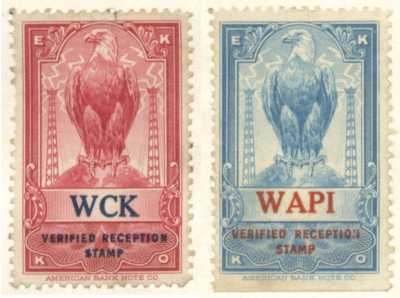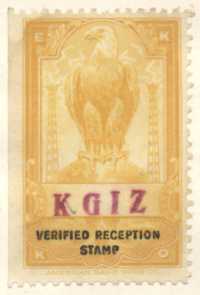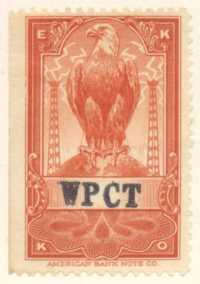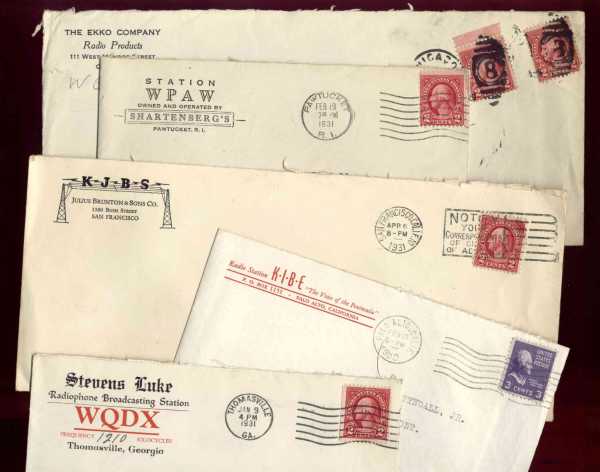EKKO Stamps
by Bonnie & Roger Riga
Radio was a new and amazing thing in the early decades of the twentieth century.
Rather similar to the Internet today, it was what everyone did in their spare time. Tuning
in a station from a distance was dependent on many factors including weather and was
something of an event. As so often happens, a company came along with an idea on how to
make money on that event. fig. 1 Two Stamps showing typeset call
letters and inscription. In 1924, the EKKO Company of Chicago had a brainstorm. They announced the production of
an album to hold stamps from radio stations all over the country, Mexico, Cuba and Canada.
It sold for $1.75 and was 96 pages long bound in a two-color cover. It had space for 650
stamps, which were arranged alphabetically by state by station. The real stroke of genius
in this plan was that EKKO would sell the beautifully engraved stamps - done by the
American Bank Note Company - to the radio stations which in turn would provide them to
listeners who could prove they had gotten that station on their radio by a description of
the program playing at the time of reception. Of course, the lazy listener could get the
stamps straight from EKKO for ten cents each. I suppose that it really depended on whether
the collector was a radio aficionado or a stamp collector, but usually it was a
combination of the two and a very powerful combination at that time. fig. 2 Stamp with hand stamped call letters
and typeset inscription. The U.S. stamps depicted an eagle between two radio transmission towers. Mexico
and Cuba also used this design, but their call letters -beginning "X" and
"C" - were easily noted. In Canada, the eagle was replaced by a beaver gnawing
on a tree. The stamps came in a variety of colors - red, dark blue, light blue, green,
olive, yellow, orange, brown and purple - and each bore the call letters of the station
and the inscription "Verified Reception Stamp." New York, Pennsylvania, Illinois
and California had the most stations issuing the stamps, all with more than forty
representatives. It isn't known just how many different stations participated, but it is
commonly thought that the number is about 650, although one collection we have seen has
what appear to be stamps from in excess of in excess of 700 different participants. fig. 3 Stamp with Hand stamped call letters
and no inscription. We say "appears" because this was a collector/radio buff on a mission
from God. This was a collection of over 5,000 EKKO stamps (not in the official album),
many of which were authentic and many more of which had been hand-produced on what must
have been blanks from EKKO. Some stamps were printed with the call letters of stations,
some were hand-stamped. Those stations participating in the program got stamps with
typeset call letters and inscription from EKKO. Stamps for non-participating stations,
which EKKO provided upon request to listeners, had hand-stamped call letters with the
typeset inscription. The collection also has many more stamps which are hand stamped but
without inscription. It has been thought that some stations did their own stamping, but
not to this degree. These appear to have been created by the collector using blanks long
after the program had ended. One wonders where and how the collector got so many blanks,
since that is the only explanation for the large number of hand-done stamps in the
collection. Accompanying the collection was box after box of correspondence from radio
stations all over the country, including Alaska and Hawaii, each verifying the reception
of their signal. While the EKKO craze lasted only for a few years, this collector worked
diligently into the 1960's to assemble this unique collection of EKKO stamps from most if
not all the radio stations in the country. fig. 4 A group of covers from the correspondence
documenting the reception of radio signals and legitimizing the existence of the stamps. The EKKO Company is no longer around, probably having gone out of business before
the second World War. Their stamps are still highly sought after by the radio topicalist,
who is quite often a radio enthusiast as well as a philatelist. It's such fun to be able
to combine two hobbies and the thrill of the chase of these relatively inexpensive but
elusive stamps makes for a very enjoyable hunt. Radio hobbyists and EKKO stamp collectors might already know of an informative site on
the Internet run by Antique Radio Classified where those interested can find more
information on EKKO stamps. Maybe a new facet of this incredibly diverse hobby will invite
you to collect. There's always something new to learn and pursue. This column first appeared in Stamp Collector and has been edited for online presentation.



This page was last updated July 9, 2016.
Copyright © 1997-2016 by Rigastamps.All rights reserved.